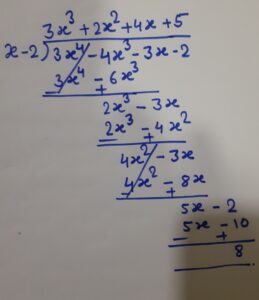Remainder theorem
Zeros of polynomials:
The value of a polynomial at
in
and is denoted by .
e.g. Find the value of at
.
Sol. On putting in given polynomial , we get
This implies .
Thus value of at
is 12.
We say that a zero of a polynomial is a number
such that
. It means
is zero of a polynomial
if the value of that polynomial at
is zero.
The zeros of polynomials is obtained by equating the given polynomial . We say
is a polynomial equation and
is root of the polynomial equation
.
Let be a constant polynomial, then
.
Now replace with any number we still get
. This implies constant polynomials has no zeros. In case of zero polynomial , every real number is a zero of the zero polynomial.
Important observations:
(i) Every linear polynomial has one and only one zero.
Let be a linear polynomial,
then means
.
So is the only zero of
.
i.e. a linear linear polynomial has one and only one zero.
(ii) A zero of polynomial need not be 0.
e. g. The zeros of are -2 and 2.
(iii) 0 may be a zero of polynomial.
e.g. Take
(iv) A polynomial can have more than one zero.
Division algorithm in polynomials:
When we divide two numbers, we always get
Dividend =(divisor x quotient)+remainder, where . When remainder becomes zero, we say divisor and quotient both are factors of dividend.
Now, let two polynomials and
. Divide
by

{ Steps to divide a polynomial by a non-zero polynomial
- First, arrange the polynomials (dividend and divisor) in the decreasing order of its degree
- Divide the first term of the dividend by the first term of the divisor to produce the first term of the quotient
- Multiply the divisor by the first term of the quotient and subtract this product from the dividend, to get the remainder.
- This remainder is the dividend now and divisor will remain same
- Again repeat from the first step, until the degree of the new dividend is less than the degree of the divisor.}
Now
Hence where
.
In general , If and
are two polynomials such that
and
, then we can find a polynomial
as quotient and
as remainder, where
or
.
In the above example the divisior is a linear polynomial . In such a situation there is a way to find the remainder called Remainder Theorem.
Remainder theorem
Let be any polynomial of degree greater than or equal to one and let
be any real number. If
is divided by the linear polynomial
, then remainder is
.
Proof. Let be any polynomial of degree greater than or equal to 1. Suppose
is divided by
then by using division algorithm theorem ,
can be written as
since degree of degree of
, this implies degree of
=0 (
degree of
)
(a constant polynomial)
In particular if then
which proves the theorem.
e.g. Find the remainder when is divided by
.
Sol. Here and zeros of
is 1.
so
=
Hence by the remainder theorem , the remainder is 2.
Also Read:
- Polynomials : Definition, Types of polynomials and Examples, Degree of a polynomial
- Relationship between Zeros and coefficients of a Polynomial
